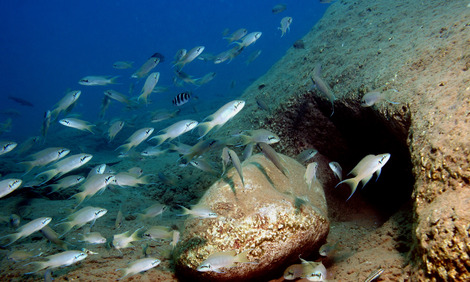"Why did you kill him?" the judge asks. The defendant answers, "By accident - I didn't mean to," and bursts into tears. He gets no punishment for the murder of millions of filter bacteria. The aquarist isn’t even aware he has committed mass murder by his well-intentioned addition of salt and now a tidal wave of problems is heading his way.
NO ADDITION OF SALT
The series of murders actually began quite harmlessly: his livebearers had chafed a little and his trusted pet shop recommended adding a bit of salt so that the fish would slime off due to the changed osmotic conditions and get rid of any parasites. This usually works quite well, but causes problems in a completely different area: The water plants do not like salt at all and the bacteria say goodbye in their millions, disappearing into bacteria heaven, if there is one. Unfortunately, bacteria do not survive a change in salinity. Prof. Dr. Reinheimer, one of the world's leading microbiologists, carried out studies on bacteria that are flushed towards the mouth of the Elbe River and found that they do not survive the increasing salinity. Only through mutating do adaptations exist that can then continue to live in the higher salinity. We aquarists should definitely take this to heart and add new filter bacteria after adding salt.
WATER CHANGE
Many aquarists are uneasy when they do their regular partial water change, because they think they are sending most of their useful, pollutant-degrading bacteria to a new home in the sewer system along with the draining water. However, the reality is that there are very few beneficial bacteria roaming around in the free aquarium water. Pathogenic (disease-causing) bacteria such as the mouth and fin rot-causing Aeromonas and Pseudomonas bacteria are more commonly found in open water, whereas pollutant-degrading bacteria such as Nitrobacter and Nitrosomonas and other genera are substrate-bound and thus need a substrate to feel comfortable and work well. Of course, we find these beneficial bacteria on every substrate in our aquarium, but an estimated 90 percent of them live in the filter. The more suitable the filter material, the more bacteria can settle there and break down proteins as well as ammonium into harmless nitrate.
SUITABLE FILTER MATERIAL
But what is a suitable filter material? Let's put it this way: The bacteria don't care at all which surface they settle on. The more surface there is, the more bacteria can live there. Foam is often the first, because it’s the cheapest choice of filter material. However, foam has the disadvantage that it gets so dirty over time that it cannot be washed out properly. That’s why foam needs be replaced from time to time. Alternatively, cleaning with 30 percent hydrogen peroxide for 24 hours followed by thorough rinsing is an option. But who wants to do that to themselves, knowing that hydrogen peroxide is not exactly a harmless substance to handle? In addition to sponges, there are a variety of filter materials that are ceramic or sintered glass based and, in addition to having an extremely large surface area, can be washed out. The more pores the better the filter material (because of the larger surface). However, we also know this has its limits: Too many small pores and channels can become clogged within a very short time and are thus no longer available for the bacteria settling in biofilms. Also, the highly praised nitrate degradation in the filter material often does not take place as easily as advertised. Nitrate is not only degraded where the bacteria crack the oxygen out of the nitrate due to lack of oxygen, but mainly where carbon is available as nourishment in addition to the lack of oxygen. Only filter material that is really specially designed for nitrate decomposition, such as " JBL BioNitratEx ", works reliably in the long term. This is because normal internal and external filters are usually thoroughly aerobic (rich in oxygen) due to the high water flow, and the bacteria do not feel compelled to break down nitrate in the presence of oxygen. In fact they do the opposite: they process nitrogen compounds into nitrate.
DEGRADATION OF SLUDGE
And then there are the heterotrophic bacteria, which can reduce the premature clogging of a filter. Unlike their ammonium and nitrite-degrading counterparts, they prefer coarse organic matter (including proteins), which are converted to the first stage of degradation, ammonium. These bacteria are offered to pond owners as "sludge degraders". But they are now also available for aquariums. By the way: Please do not buy filters like cars according to the motto "The faster and more powerful, the better", because it is exactly the other way round. If the water flows too fast, the degradation performance is reduced. If you have two filters with the same pump capacity to choose from, please select the one with the larger filter volume.
WASHING OUT FILTER MATERIAL
Speaking of washing out filter material: For decades, the opinion persisted that biologically running filters (which ones aren't?) should not be cleaned too often, because otherwise they would no longer run properly biologically. Now, however, all the experts are in agreement that filters, in addition to their useful functions, are also bacterial slingshots and, unfortunately, are also a breeding chamber for pathogenic bacteria. Regular cleaning lowers the bacterial count and thus the infection pressure in the aquarium. To summarise: Filter volume takes precedence over pump performance, porous filter material is preferable to sponges, clean more often than too infrequently and restart the filter with a bacteria starter after adding salt (if necessary). You can easily check the effectiveness of your filter: A nitrite test and an ammonium test should always show zero. Then you know you’re doing everything right!
